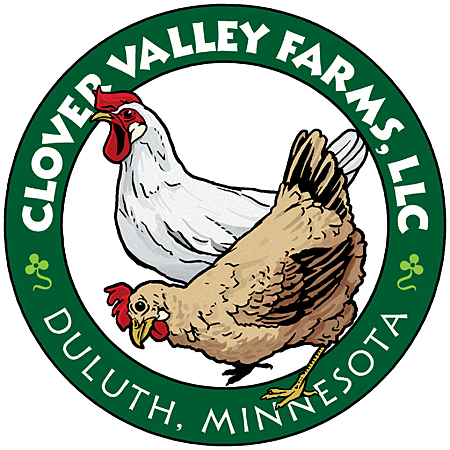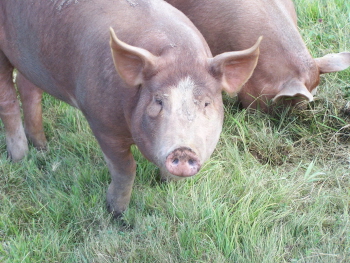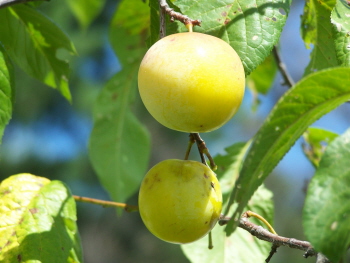Apples & Other Fruits
Varieties
Table 5a shows the varieties of each type of tree fruit in their 2010 inventory, and Table 5b shows small fruits. Some apple varieties are unknown because the trees preceded Jeff and Cindy’s time on the farm; other varieties are unknown because they are antique or heritage varieties or because of inadequate record keeping early on (an important lesson learned!).
Cindy and Jeff have one or two trees or bushes per variety for most of their varieties, up to 5 or 6 plants per variety as of 2010. They have chosen to grow a number of apple varieties because of a personal interest in heritage apples and because mixes of varieties give more flavor to cider and other value-added products they want to offer (see Production > Harvest & Processing > Apples & Other Fruits).
Initially Jeff and Cindy obtained most of their fruit trees and bushes from a variety of nurseries and the Duluth Community Garden Program. Recently they have been developing their own trees by grafting desirable fruit varieties from scion exchanges through MOSES and the Sustainable Farming Association of Minnesota (SFA) onto a range of cold-hardy rootstocks (see below).
Educator’s Perspective: Resource Tip The University of Minnesota Extension fact sheet Fruits for Minnesota provides recommendations for cultivars suitable for growing in the state’s four regions. There are tables for apples (early, mid, and late season), pears, apricots, plums (European and hybrid), cherries (plum, tart, and Nanking), raspberries (summer- and fall-bearing), strawberries (June- and ever-bearing), blueberries, grapes (table, juice, and jelly, plus seeded vs. seedless), mulberries, juneberries, elderberries, gooseberries, and currants (red and black). There is also an explanation of which fruits need multiple cultivars for fruit set. |
Table 5a. Varieties of tree fruits in 20101
Apples2 |
Cherries |
|
UMN #1628 (unnamed variety) |
Evan’s Bali |
Pears |
|
Bosc |
|
Plums |
|
Black Ice |
1Some varieties in this table are not known to be hardy in areas north of Duluth.
2Detailed information about some of these varieties can be found linked to the web page for the Heritage Orchard at University of Minnesota Duluth.
3Cindy and Jeff have been unable to identify some varieties and have named and described them themselves for record keeping purposes. The Clover Valley Antique, for example, produces mid- to late-season very nice, firm, red fruits that have white flesh and are great for drying, baking, and cidering.
Table 5b. Varieties of small fruits in 2010
Currants |
Juneberries |
Black Russian |
Regent |
Educator’s Perspective: Resource Tip The University of Minnesota Extension fact sheet Currants and Gooseberries in the Home Garden describes research, cultivars, site selection, planting, pruning, harvesting, diseases, and insect pests for these two related fruits. Although the fact sheet is geared toward the home gardener, much of the information is relevant to commercial production. The fact sheet includes an explanation of white pine blister rust, a fungus that affects white pine trees and uses currant and gooseberry bushes as alternate hosts, and how this fungus has impacted currant and gooseberry production in the U.S. |
Educator’s Perspective: Resource Tip Although juneberries grow wild in Minnesota and have been picked and used in homemade jams and similar products for generations, they are just starting to make a name for themselves as a fruit crop in the state and elsewhere. The species used in commercial production is Amelanchier alnifolia. Two Minnesota farmers began evaluating the commercial potential of juneberries in 2005 and summarized their findings in the MDA’s Greenbook 2008 with an article entitled Developing a Saskatoon Berry Market in the Upper Midwest. A similar effort is underway in the northeastern U.S.; see Small-scale Commercial Juneberry Establishment and Marketing from the Cornell Cooperative Extension of Ontario County, New York. Honeyberries are another up-and-coming small fruit. Also called haskap in Canada, or edible blue honeysuckle (Lonicera caerulea), they originate from Siberia, China, and Japan. The fruits are cold-hardy, ripen earlier than strawberries, and look like oblong blueberries. They have a unique taste, sometimes compared to blueberries but also with hints of raspberries, currants, and other fruits. Much of the breeding of honeyberry varieties in North America has occurred at the University of Saskatchewan Fruit Program. Some of these varieties were planted in 2011 for testing at northern Minnesota’s North Central Research and Outreach Center. |
 |
 |


